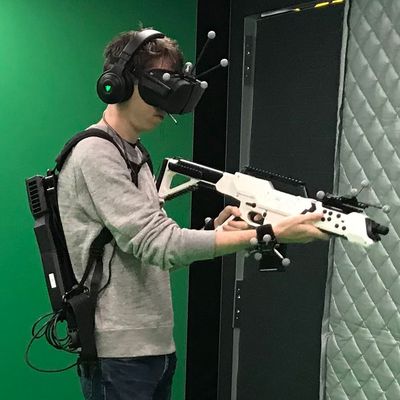
When it hit store shelves just a few years ago — preceded by a garage-tinkerer origin story, a successful Kickstarter campaign, and a $2 billion acquisition by Facebook — the Oculus Rift was the first VR headset to make virtual reality attainable for the common man.
Or so the thinking went. The reality (actual, not virtual) was something different. Getting a Rift up and running took a significant financial investment, since one needed a PC with a capable graphics card and processor, in addition the $600 headset (it’s now $400). You also needed considerable physical space, with enough floor space to move around comfortably while the system tracked the motion of your head and arms. Unless you had a spare room in your house, you were basically out of luck when it came to the ideal Rift experience.
It looks increasingly clear that setups like the Rift (and similar headsets like HTC’s Vive) are becoming a sort of VR middle ground unfit for anyone who’s not into PC gaming. Last month, Facebook released the Oculus Go, a wireless headset that runs on the same configuration as headsets like the Samsung Gear, which slotted a smartphone into a set of goggles to form a makeshift system. In effect, the Go is an entry-level VR headset that you don’t need a phone for, and it’s priced for that purpose at $200. It’s more than functional for playing mobile-quality games, and it should be fine for VR “experiences,” like chatting with friends, or concerts and sports events, which Facebook has found users respond to positively. So positively in fact that the company recently announced a slew of VR events for this summer.
On the opposite end of the spectrum is an advanced system developed by Sandbox VR, which I tried out last week at a movie theater in Times Square. Sandbox was founded by Steve Zhao, who described the current VR landscape as a “disappointment” that lacked “embodiment” — UIs full of floating hands keeping the user from fully immersing themselves.
Whereas the Go is just a wireless headset and simple controller, Sandbox’s rig is the size of a small apartment. In order to play it, you have to strap motion-tracking bands on your wrists and ankles, and wear a backpack connected to the VR headset (the backpack is a laptop computer). You then enter a green-screened area surrounded by cameras which track your motion, loaded with gear but untethered and free to move about the space freely.
In the game I played with a partner, Deadwood Mansion, the players are confined to a small area in a haunted mansion’s foyer, and move around and kill zombies using a toy gun that the VR system also tracks. It’s immersive enough. Later in the game, lasers move toward you and your partner, necessitating communication about when to duck and where to move. Zooming out, the game is obviously simplistic, but I was still a little disoriented (in a good way) when I pulled off the goggles after playing the game for about half an hour straight.
It’s fun! The game itself is not particularly thrilling in retrospect, but a lot of the novelty comes from moving around a virtual space in the exact same way you might a physical one, and seeing your partner do the same. (Though it wasn’t available at my trial run, Sandbox does make a vest that offers haptic feedback; in other words, if you get shot in the chest, you’ll feel it.) In the moment, the VR system works well, and further refinements are inevitable. Given that tickets to a Sandbox experience hover in the $30 range, it’s not hard to imagine this type of amusement setup in movie theaters or Dave & Busters at some point in the not-too-distant future.
What both of these recent experiences helped stress is the idea that VR will become mainstream not by hitting a sweet spot between ease of use and technical powerhouse, but, more likely, by being one or the other. There’s the “good enough” option of the Oculus Go, competent for pretty much anything that’s not high-end gaming, and there are setups like Sandbox’s, venues you go to in order to experience highly immersive VR in the same way you might go to a movie or arcade.





























